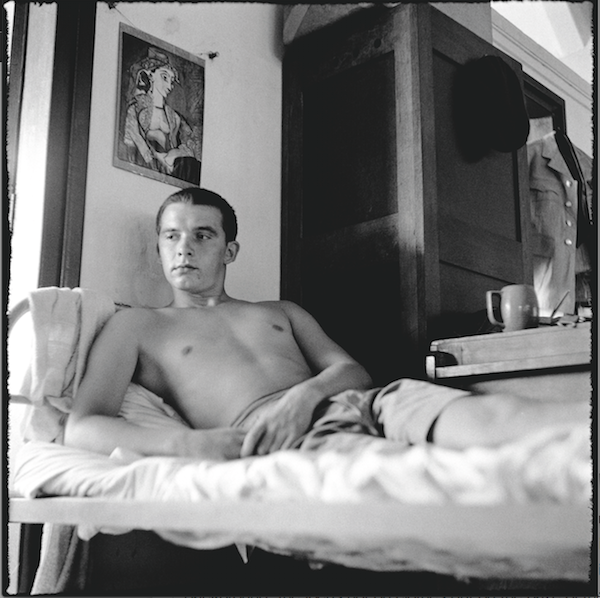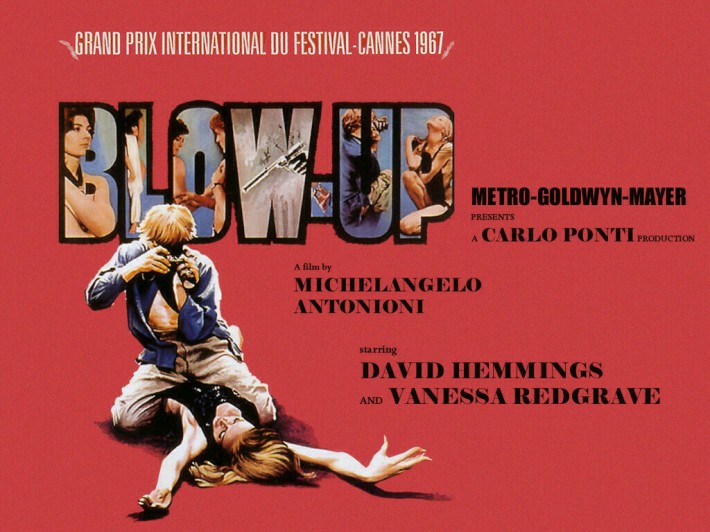David Bailey is a master of portrait photography. His four month gallery exhibition “Stardust” just closed in London. It took 3 years of planning to put it together, and looked at his 50+ years as a photographer and artist. I got to see it before it closed, but if you didn’t get a chance to go, don’t worry – here are five things that I think made Bailey the success we celebrate today, and what we can learn from him.
‘It takes a lot of imagination to be a good photographer … it takes a lot of looking before you learn to see the extraordinary’

David Bailey is often seen as one of the cornerstones of the birth of the “swinging 60’s” London cultural scene, the era that spawned the likes of the 1966 film “Blow Up”, whose central character was based on Bailey’s career and personality at the time.

It’s short sighted to dwell on this aspect of his prolific photographic career. We need to focus on who he was to better understand what he did. Bailey changed the way things were done, yet come from incredible humble beginnings.
How did he do it?
I've been thinking about this since the exhibition, and I've outlined five important components I think that helped propel his career, and which more importantly, we can all take something from and apply to our own lives.
1). He Cleared Defined And Focused On His Own Path
“If you were born in the East End, there was only 3 things you could become – a boxer, a car thief and maybe a musician”.
*(side note - the East End is a blue collar, working class area of east London)

Bailey was born into a working class family and was dyslexic (and therefore written off academically in school, being told he was “stupid”). He was the complete opposite of what fashion photographers represented at the time. Brian Duffy, one of Bailey’s contemporaries and peers and another “working class” fashion photographer said ““Before 1960, a fashion photographer was tall, thin and camp – we were short, fat and heterosexual”.
 L-R: Bailey, Duffy and Donovan
L-R: Bailey, Duffy and Donovan
The odds were stacked completely against him, yet he prospered. What is there to learn here?
Resilience, focus and a clear set of goals are critical but so is a sense of self belief. We will all get knock backs but having a clear vision and not taking no for an answer when it feels like we're on our path will give ourselves a good chance. Critically, Bailey simply didn’t care he didn’t “fit the mold”; he went out, broke it, and reinvented it around his own ideals.
2). You Connection With Your Subject Is More Important Than Your Gear Or Technical Ability
“The pictures I take are simple and direct and about the person I’m photographing, and not about me. I spend more time talking to the person than I do taking pictures.”
Bailey was not technically inept by any means; he understood lighting brilliantly, but never got hung up on it.
"All that worrying about poncy lighting, making people look like landscapes or rocks. If I wanted to photograph a f**king rock, I'd photograph a f**king rock" he said when talking about his technique for his “Bailey’s Democracy” nude project.
His first camera that launched his career was a cheap knock off Rolleiflex copy that he picked up in Singapore while serving in the Air Force.
He kept things simple, and focused on connecting with his subject (sometimes literally, as he developed something of a playboy reputation for his various romances and relationships with the models he would work with).

Bailey became known for his own notion of natural portraiture portraying models not as stiff mannequins, but as real human beings, people he engaged and empathized with and – as a result – drew out their personalities. He forever changed the role, notoriety and status of models the world over. His work shooting Jean Shrimpton was a defining moment in the birth of the “supermodel”.
 Kate Moss 2013
Kate Moss 2013 Jean Shrimpton, 1960s
Jean Shrimpton, 1960sHe was essentially bringing something of himself to every shoot. This interview with Paulene Stone, who featured in Bailey’s earlier fashion shoots, details more of this process (skip to 15min 30)
He recognized the need to channel something of our own selves into our work, via our connection with our subjects. This aside from all the gear and lighting in the world, will help set us apart and drive us forward.
3). He Recognized His Weaknesses - And Turned Them Into His Strengths
Bailey was both an outsider (he went against the previously trodden grain of what fashion photographers “were” before he, Duffy and Donovan arrived on the scene) and an insider (being outside the “establishment” gave him creditability and access to the new “popocracy” movement). This allowed him to tread interesting ground and bridge a gap to a new cultural movement.
 John and Paul being shot by Bailey
John and Paul being shot by BaileyWhether he did it intentionally or not, his “outside” status was parlayed expertly as an “insider” to many of the musicians, gangsters, models, celebs and actors he would later photograph, who themselves could often be found on the periphery of “the establishment”.
 Bailey and Salvador Dali
Bailey and Salvador Dali
 Mick Jagger smiles for the cover of Bailey's "Rock and Roll Heroes" book
Mick Jagger smiles for the cover of Bailey's "Rock and Roll Heroes" book
The point here is the importance of focus on the right things. We all too often see what we don’t have, what we think we need and miss what we are able to do here and now with what we do have. Bailey is a great example as a photographer who not only goes out and says “no excuses” but also parlays his weaknesses into strengths.
4). His Photographic Style And Sensibility Was Defined By His Personality
Although a white background had been used before him by Richard Avedon and Cecil Beaton, it was Bailey that really pushed it hard.
His “Box Of Pin Ups” project in 1965 saw him mixing the white background with harsh lighting, tonal compression and high contrast printing to give a sharp edged precision to his images.

He stripped the background to white to totally isolate his subjects, cropping them in impossibly tight compositions at times. His own upbringing and background, as well as his feeling of being compartmentalized as a result of his class could easily have played a role in the development of his photographic sensibility here.
Pop psychology aside, what this means is really we should embrace who we are, the constraints we go through and the challenges we endure as a means to affect and mould our own creative vision and approach to our work. Whether this is a lighting style, or how we connect with our subject barely matters – it’s about being clear on what drives, inspires and motivates us that is important.
5). His Commitment to Personal Work
Bailey has always maintained an admiration for the street reportage and documentary work of Cartier-Bresson, Diane Arbus and Robert Frank. He’s used commercial success as a means to go off and make portraits in far flung places across the globe on non-commissioned trips. He has a love for the unknown, for finding people “that had not been seen to death”.

Taking time away from commissioned client projects is critically important, and helps avoid burn out while keeping us inspired. Whether you fly to some far off corner of the planet or make portraits of people in your neighborhood is less important than having a personal project that keeps you inspired and motivated to explore your photography and revitalize your eye.
Final Thoughts
“Stardust” took Bailey 3 years to plan. You can hear his thoughts on the exhibition in this British Vogue interview:
https://www.youtube.com/watch?v=7-ZkSe0Wlzg
If you missed it, I can wholeheartedly recommend the book that covers the exhibition, available on Amazon here.
When we look at his extensive career, you realize that the very “weaknesses” Bailey had – coming from left-of-field for the “fashion photographer” set at the time; coming from a working class background – was exactly what helped propel him forward in his early career in the first place, because it allowed him to better connect with the people he wanted to shoot.
The fact he recognized this – and allowed his background and character to better connect with his subjects as well as forge his stylistic approach – drove him ever forward. He took the gear and technical know-how as a given. If we are to really progress, we must look inside ourselves and see what it is that moves us, if we hope to better connect with our subjects in any way like he has succeeded in doing.
“Photography – like painting – is all about looking for me. You have to keep looking until you see”.

Would love to hear what you think of Bailey, his work and his approach. Is there anything you’ve applied from your own background, character to your photography? What “weaknesses” have your turned into positives? Please share with the community in the comments below.
Images via / Credit to: [NPG] / [David Bailey]







John and Ringo?
I do believe this is John and Paul!
Come ON!
How quickly they forget....
Awesome photos, one of my favorite photographers. Saw some of his work in an exhibition many years ago.
I saw this exhibition in London last month. Bailey was always a massive inspiration to me and always will be and to see his work in the flesh was such an honour.
The exhibition was physically huge, larger than any other photographic exhibition I've seen before. The images where all logically group into musicians, actors, fashion industry etc. It also included some of his lesser known personal work such as the images of tribes taken which he shot on location as well as some of his newer stuff such as his images of flowers and skulls.
Easily the best exhibition I've ever seen. I've leave you with a snap from my Instagram of the giant Michael Caine that greets visitors to the gallery. Note the escalator for scale.
wow that's huge, how did i miss that?!?! Glad you seemed to enjoy it as much as i did Alex